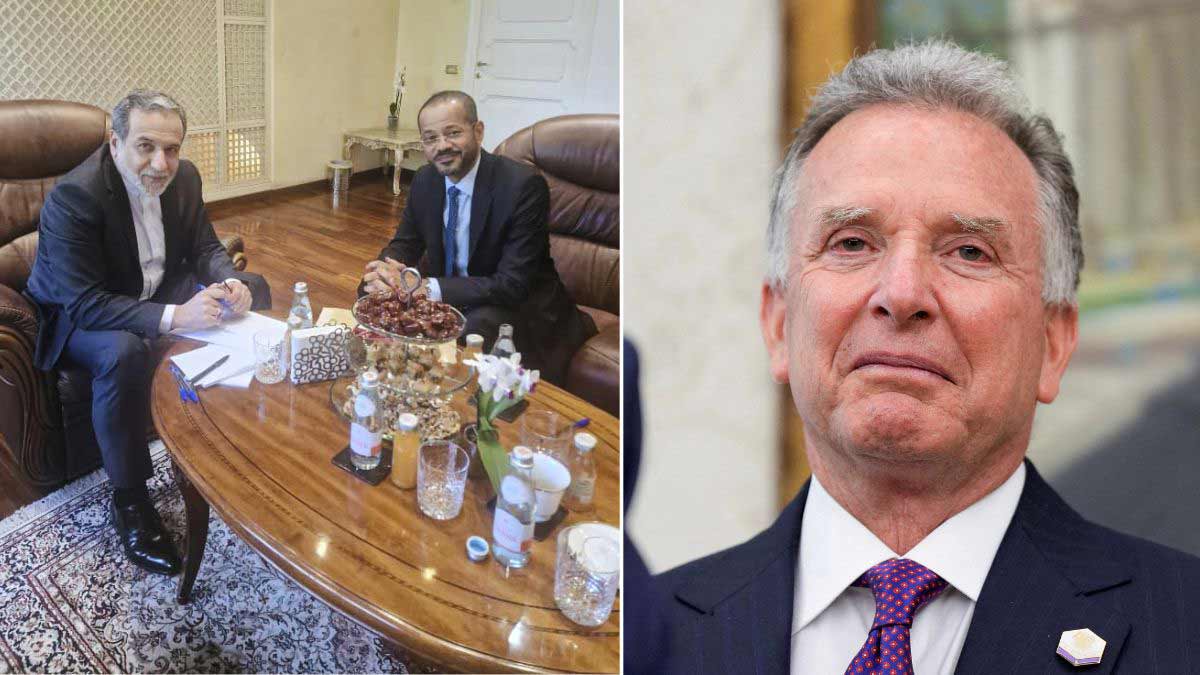US offers Iran nuclear deal proposal even as IAEA warns of surging enrichment
 Iranian Foreign Minister Abbas Araghchi (left) meets his Omani counterpart Sayyid Badr Albusaidi at the Omani Embassy in Rome | AP; US Special Envoy Steve Witkoff | Reuters
Iranian Foreign Minister Abbas Araghchi (left) meets his Omani counterpart Sayyid Badr Albusaidi at the Omani Embassy in Rome | AP; US Special Envoy Steve Witkoff | Reuters
The United States presented its first formal proposal for a nuclear agreement to Iran on June 1, only hours after United Nations inspectors reported a sharp increase in Tehran’s stockpile of highly enriched uranium. The document proposes a halt to all uranium enrichment by Iran and calls for the creation of a regional nuclear power consortium involving Iran, Saudi Arabia, other Arab states and the United States.
This was the first written proposal delivered by lead US negotiator Steve Witkoff since talks with Tehran began in early April. The proposal was sent through Omani intermediaries and made public in a tweet by Iranian Foreign Minister Abbas Araghchi. The White House later confirmed the news.
"President Trump has made it clear that Iran can never obtain a nuclear bomb," said White House press secretary Karoline Leavitt. "Special Envoy Witkoff has sent a detailed and acceptable proposal to the Iranian regime, and it’s in their best interest to accept it. Out of respect for the ongoing deal, the administration will not comment on details of the proposal."
Araghchi responded that Tehran would evaluate the offer "in line with the principles, national interests and rights of the people of Iran." He reiterated that Iran would not abandon its right to enrich uranium for civilian purposes, a capability that maintains its position as a threshold nuclear state—able to quickly develop weapons if it chooses.
A new report by the International Atomic Energy Agency (IAEA), released on June 1, revealed that Iran has stockpiled 408.6kg of uranium enriched up to 60 per cent, just below weapons-grade. This marks a nearly 50 per cent increase since February. According to the IAEA, this amount of uranium could be further enriched to produce fuel for about 10 nuclear weapons.
The quarterly IAEA report describes Iran’s enrichment levels as a source of “serious concern,” noting that it is the only non-nuclear-armed state producing uranium at such high levels. IAEA Director General Rafael Grossi warned that a diplomatic resolution was urgently needed, ideally one that includes a “very robust” inspection regime. While Iran has allowed inspectors to measure enriched uranium, it has disabled many of the agency’s cameras and sensors at key sites in recent years.
The IAEA's findings are expected to be central to a push by the United States, Britain, France and Germany at the agency’s next Board of Governors meeting, scheduled for June 9. Western diplomats are preparing a resolution to declare Iran in violation of its non-proliferation commitments, which could eventually lead to a referral to the UN Security Council. If passed, it would be the first such finding against Iran in nearly two decades.
Israel, which is not a signatory to the Nuclear Non-Proliferation Treaty and is widely believed to possess its own nuclear arsenal, issued a statement following the IAEA disclosures. "Such a level of enrichment exists only in countries actively pursuing nuclear weapons and has no civilian justification whatsoever," said the office of Prime Minister Benjamin Netanyahu. He urged immediate international action, although he did not issue any military threats.
The heightened enrichment activity appears to be part of Tehran’s strategy to gain leverage in the negotiations. The IAEA report also referenced a secret Iranian nuclear programme believed to have operated until the early 2000s, involving sites in Lavisan-Shian, Varamin and Turquzabad. Iran denies these sites were used for nuclear activities and claims the nuclear traces found there were planted.
The IAEA inspectors, however, dismissed Iran’s explanations, citing "a lack of technically credible answers." Another report by the agency noted that Tehran has continued to obstruct access to military sites suspected of hosting past nuclear experiments. US intelligence has previously concluded that Iran suspended its nuclear weapons programme in 2003, though Israeli officials contend elements of the programme persisted under the direction of Mohsen Fakhrizadeh, who was assassinated in 2020 in a remote-controlled ambush widely attributed to Israel.
Trump administration officials estimate that Iran could produce weapons-grade uranium in under two weeks and potentially assemble a crude nuclear device within months if it chose to pursue that path.
The US proposal currently on the table seeks to prevent such an outcome by securing an agreement that dismantles Iran’s most advanced nuclear facilities and imposes strict inspection protocols. However, the Iranians have insisted they will not dismantle infrastructure built at significant national expense, especially given its exposure to repeated sabotage by Israeli and American intelligence services.
Meanwhile, tensions between Tehran and European powers have escalated. On June 2, Araghchi warned that Iran would retaliate if Britain, France and Germany attempted to “exploit” the IAEA findings to pressure Tehran. He said he had conveyed Iran’s position directly to Grossi during a phone call.
Despite the rising stakes, Trump has expressed optimism that diplomacy may prevail. He confirmed recent reports that Israel had urged him to join in a military strike on Iran’s nuclear facilities, but said he had asked Netanyahu to hold off in light of the ongoing negotiations.
"I want it (nuclear agreement) very strong where we can go in with inspectors, we can take whatever we want, we can blow up whatever we want, but nobody getting killed," said Trump. "We can blow up a lab, but nobody is gonna be in a lab, as opposed to everybody being in the lab and blowing it up."
Middle East